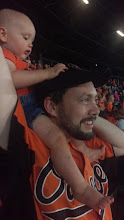 There's a lot to like about this card. I'll start with the design - though 1970's Topps set is often maligned for being drab and dull, its biggest crime is being the set that came just before the revolutionary black bordered 1971 cards. There's something understated and classy about these simple gray borders, and I like the script that the player name is rendered in; it's a font I don't recall seeing on any other cards, and it's somehow reminiscent of a 1950's diner.
There's a lot to like about this card. I'll start with the design - though 1970's Topps set is often maligned for being drab and dull, its biggest crime is being the set that came just before the revolutionary black bordered 1971 cards. There's something understated and classy about these simple gray borders, and I like the script that the player name is rendered in; it's a font I don't recall seeing on any other cards, and it's somehow reminiscent of a 1950's diner.I also love the players in the background, backs to the camera. I've come to enjoy the quirks of baseball card photography, particularly guys who make cameos on other player's cards. In this case, the humongous Gene "Lurch" Brabender (of Ball Four fame) stands to Hall's right, our left. On the other side of him is #9.
The artful presentation of Dick Hall himself lends a certain charm to this photo, as the extreme closeup lends a sense of action to a posed shot. He is following through with his not-quite-sidearm, not-quite-three-quarters delivery, eyebrows arched in anticipation of the batter's reaction. To top it off, he's wearing that glorious "Baltimore" road jersey.
What adds to my enjoyment to this card is the fact that I've exchanged a few emails with Dick Hall. A week after I launched the NumerOlogy website, the Orioles Hall of Famer contacted me to complement me on my work. He was known for wearing #29 as an O, but was fairly sure that he'd worn another number when the team first acquired him from the Kansas City Athletics in 1961. He even went so far as to guess that it might have been 38, though he was uncertain. I went back to my sources and sure enough, baseballalmanac.com listed him as #29 and #38 in 1961. I'd previously discounted it because pitcher Dick Hyde was also #38, but it turned out that he joined the team after Hall, making it probable that there was a number switch when Hyde arrived. So the first correction to my research came straight from the source. To spin it another way, a friend assured me that I must be an authority if I had former players coming to me to find out which numbers they wore!
As a postscript, I've recently emailed Dick to ask if he'd consent to an interview to be posted on the homepage of NumerOlogy. If he agrees, I'll put up a link when it goes live.


No comments:
Post a Comment